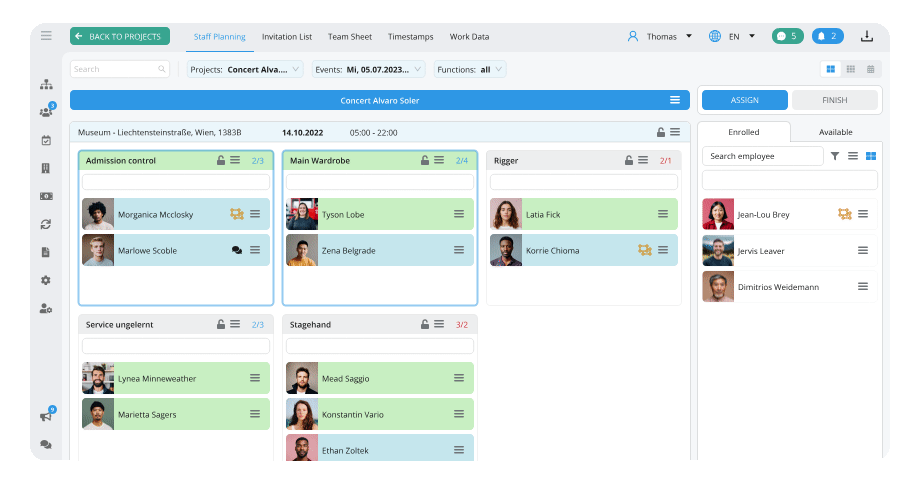Companies who regularly hire flexible and temporary workers are well aware of the challenges this presents. One of them is that both sides make a smaller commitment, leading to greater uncertainty in scheduling. Of course, businesses want personnel who are available at the right time, in the right place, and who provide the right skills. Potential staff members, on the other hand, would like to see transparent scheduling, which they are informed about well in advance, and which fulfils their requirements.
Ideally, both parties' needs can be reconciled by taking into account which hours employees would like to work and when they are available. This increases their readiness to keep working for your company again and again, and ensures that you have reliable and qualified personnel at your disposal when needed.
What staff would like to see in scheduling
Staff-oriented employee scheduling takes personal needs into consideration as early on as possible. What is most important here are the individual availabilities and the desired working hours. Employees who study or have a second job, for example, are often only able to work certain days or times. Holidays, exam weeks or a longer trip abroad can also lead to unavailability on their part.
In addition, staff members might like to work on certain projects, maybe because they get on well with a client, a specific place of work is easy to reach, or they are already familiar with a project's tasks and processes. Perhaps they prefer to work with team members they already know well and like to collaborate with. This can also be helpful in terms of carpooling.
And of course, everyone would like to be given work which fits well with their education, skills and experience.
What businesses require when scheduling
On the business side, there is the need for temporary workers. This may arise from different circumstances, such as dealing with staff shortages, industry-specific seasonal demand (e.g. in the foodservice industry), or the need for more workers in a certain building (e.g. in the case of cleaning companies).
To meet all needs - those of the company and the workers - is a tenuous balancing act without the help of technology.
Any open positions need to be filled with temp workers who do not only need to have the right qualifications, but also need to be available. Ideally, businesses would have a pool of potential employees who have worked for the company before and can be called if needed.
What does good employee scheduling look like?
Good scheduling solutions take staff members' needs into account right from the start. The more they can have a say in when and how they work, the more satisfied your employees are. If they can be asked if they are available early on, or can submit their availability themselves, this creates more certainty and allows employees to feel more connected to the company and the project. Transparent scheduling also enables staff members to easily and quickly swap shifts without the employer having to get involved.
The more influence staff members are allowed to have on their own scheduling, the happier they are at work.
Another important point concerns ad-hoc changes. Often, affected employees do not feel that they are given enough notice if they have to take on extra shifts or work extra hours. Here, it is important that the scheduling system is transparent and allows for easy communication, meaning that changes can be discussed quickly and without added complexity, ultimately leading to staff members feeling more valued.
When a company manages to balance its own needs with those of its employees by seamlessly taking their availability and preferences into account, this leads to more satisfaction on all sides.
How to improve the processes and technologies used in staff scheduling
In many businesses, scheduling is still done on Excel sheets or via Doodle, while SMS, WhatsApp or email are used for communication purposes. Aside from the data protection requirements and regulations which are often not met through these channels, they also make liaising with employees into a time-intensive and error-prone process - particularly where ad-hoc changes are concerned.
The right technology can be helpful here. As smartphones become more and more prevalent, the importance of scheduling tools becomes increasingly apparent. These tools can integrate seamlessly with smartphone apps for your employees, and they do not only allow companies to plan shifts, but also offer their own communication channels, time tracking features, as well as data exports for payroll processing.
In a nutshell
If you would like to attract flexible and temp staff, you need transparent and employee-focused scheduling which takes their individual requirements and preferences into account. Staffcloud creates a balance between the company's and staff members' needs, therefore leading to more satisfaction all around and raising the likelihood of future collaborations.
To apply a market principle, you should also offer employees something they cannot get elsewhere, such as:
- Good working conditions
- Plenty of notice regarding shifts
- Making them feel valued (e.g. through direct communication and job matching)
- Competitive (above average) pay









